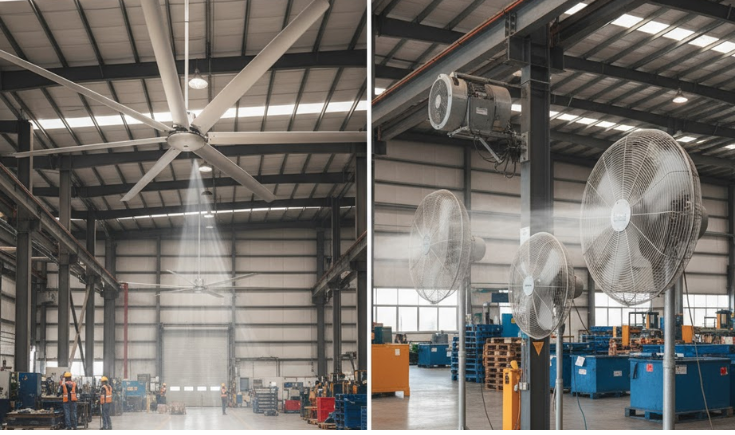- Gala No. 19, 2nd Floor,
Bail Bazar, Mumbai, India - +91 88 5002 0455
info@alfafans.in


When it comes to maintaining airflow, temperature control, and comfort in large industrial spaces, choosing the right fan is crucial. Two common options are HVLS fans (High Volume Low Speed) and conventional industrial fans.
But which one suits your facility better? In this guide, we’ll compare HVLS vs conventional fans in terms of performance, energy efficiency, cost, and applications - helping you make the best decision for your space.
HVLS (High Volume Low Speed) fans are large-diameter fans - typically ranging from 7 to 24 feet - designed to move a massive volume of air at a low rotational speed.
These fans are commonly used in warehouses, factories, gymnasiums, airports, and logistics centers where wide-area air movement is essential.
Conventional industrial fans include axial, centrifugal, and wall-mounted fans that operate at higher speeds to create focused airflow.
These fans are often found in machine shops, manufacturing lines, workshops, and smaller warehouses where targeted airflow is needed.
| Feature | HVLS Fans | Conventional Industrial Fans |
|---|---|---|
| Airflow Coverage | Covers large areas (up to 20,000 sq. ft.) | Limited to specific zones |
| Air Speed | Low speed, gentle breeze | High speed, focused airflow |
| Energy Efficiency | Highly energy-efficient (up to 70% savings) | Consumes more energy for similar airflow |
| Noise Level | Very quiet | Moderate to loud depending on type |
| Installation | Ceiling-mounted, requires space and height | Easy wall or floor installation |
| Maintenance | Low maintenance | Moderate to high depending on fan type |
| Best For | Large open areas (warehouses, hangars) | Small to medium areas (workstations, tunnels) |
The right fan depends on your space size, ventilation needs, and energy goals:
You manage large open spaces (warehouses, factories, gyms) and want to reduce energy costs while improving comfort and air quality.
You need localized cooling or ventilation for small areas and have a limited installation budget.
For many industrial facilities, a hybrid approach - using HVLS fans for general air movement and smaller conventional fans for targeted zones - offers the best overall results.
Both HVLS fans and conventional industrial fans play vital roles in industrial ventilation. However, HVLS fans are increasingly becoming the go-to solution for companies seeking energy efficiency, comfort, and sustainability.
Investing in the right fan system not only enhances workplace conditions but also leads to long-term operational savings.
Talk to our team to find the right fan solution—from HVLS to heavy-duty exhaust fans—to optimize the air quality in your facility.